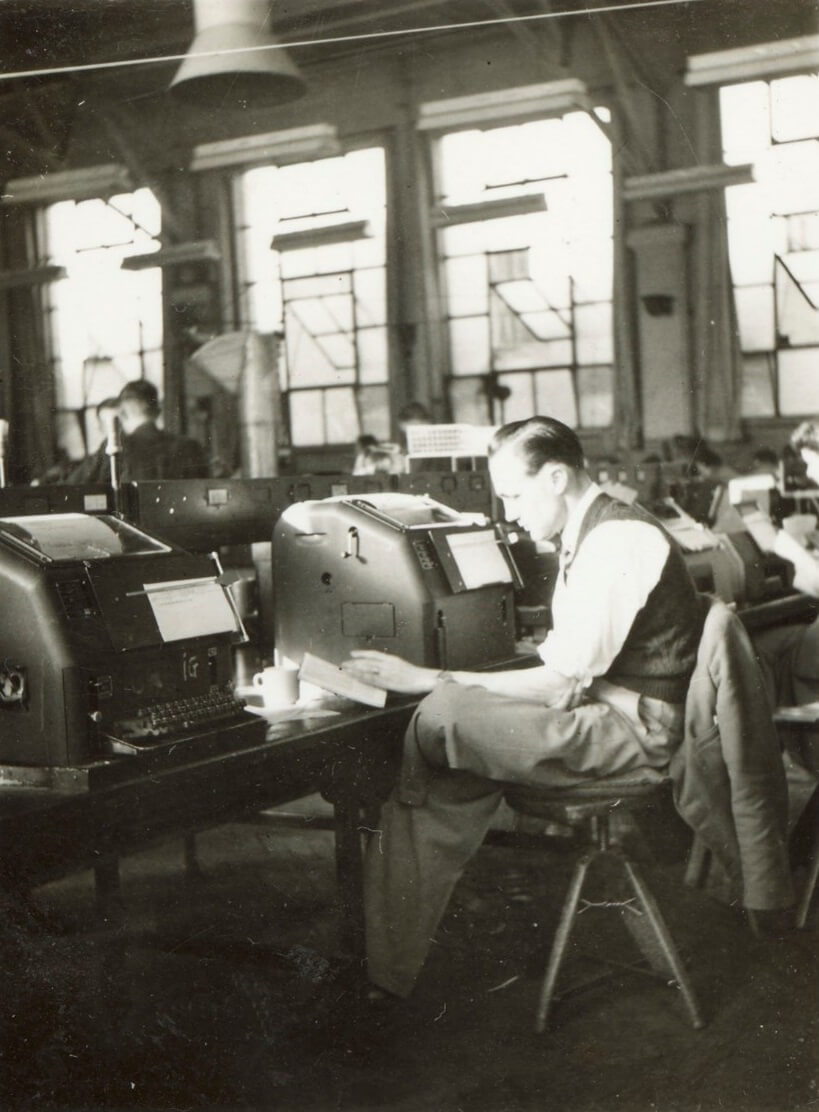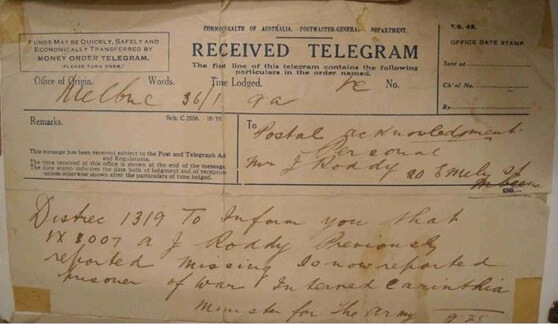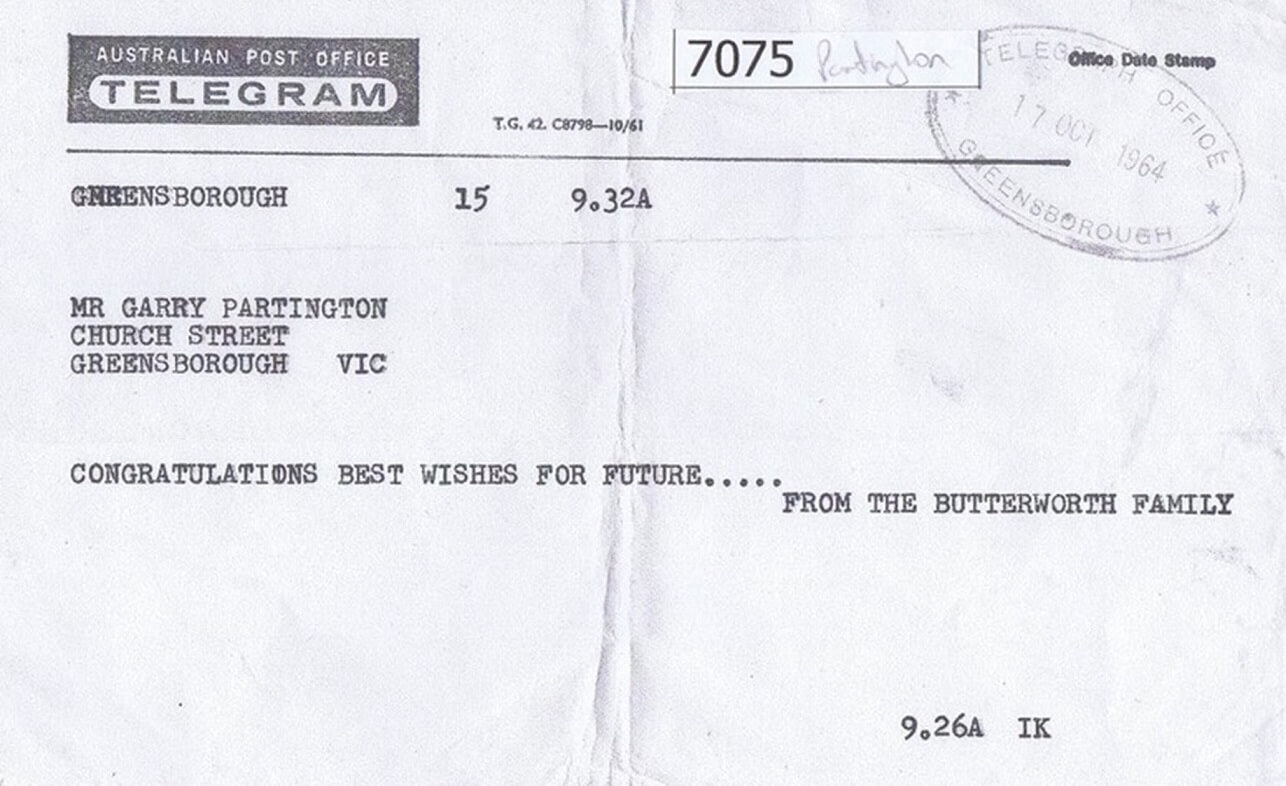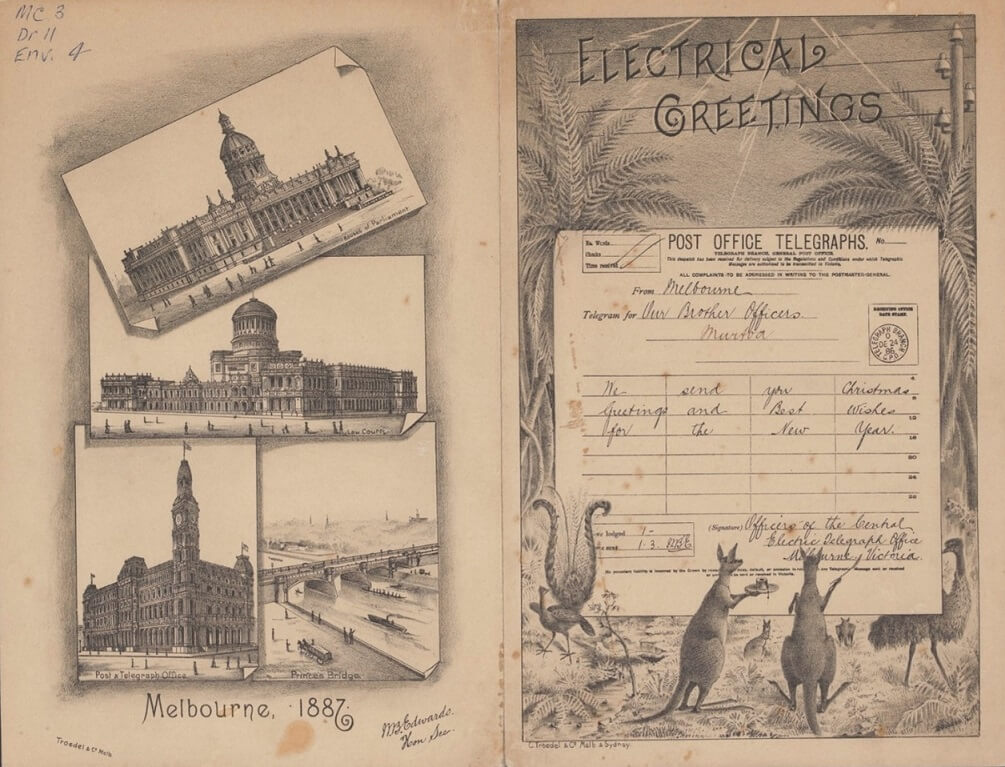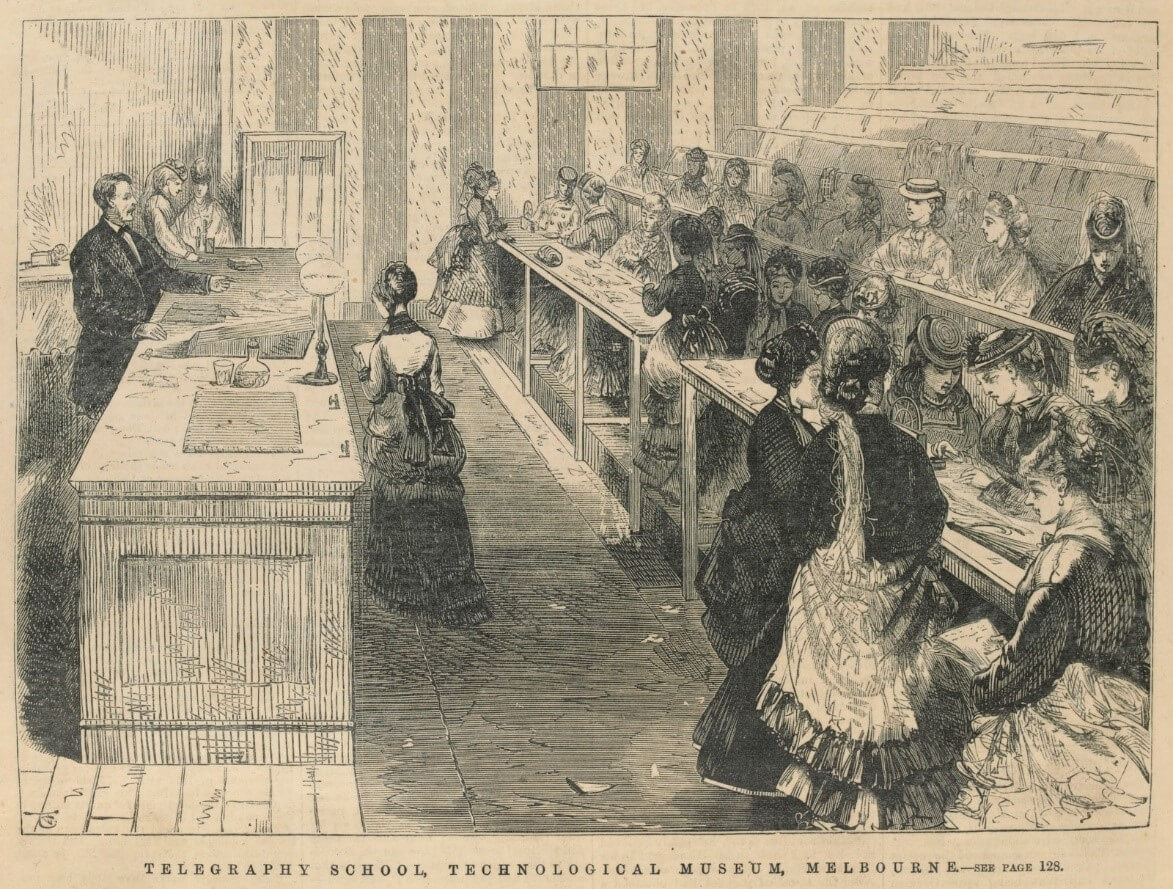Telegrams were sent as coded pulses over telegraph wires and a new occupation was created to send them. The telegrapher learned to send messages using a special code, known as Morse code, which transmitted pulses over the wires in combinations of short and long pulses, represented on paper as ‘dots’ and ‘dashes’. The most famous combination was the distress signal, ‘SOS’, coded as three dots, three dashes and three dots. This was already in use for ships at sea using flashing light and is still understood today. Telegraphers depressed a metal key on a tapping machine to create the pulses and became extremely proficient at sending messages very quickly. At the receiving end the message was recorded, decoded, transferred to paper and delivered without delay, usually by a telegram ‘boy’. In the city telegram boys might walk to a destination, but in the suburbs and regional Victoria a bicycle or horse was usual.
Telegraph Office employees, Melbourne, 1949
Reproduced courtesy State Library Victoria
Telegrapher seated at teleprinter.
Telegrams were an immense boon to business (including newspapers) and were soon commonplace, but they were always relatively expensive and were usually only used to send brief messages. Senders learned to be concise. In 1854 the rate for a telegram in Melbourne was 2 shillings and sixpence for less than ten words, with three pence for each additional word (exclusive of name and address). Punctuation also incurred a charge and tended to be omitted, with the exception of the use of the word ‘STOP’ (full stop), which was free. As usage expanded, the rates charged actually fell. In 1885 the telegram rate within Victoria was sixpence for six words, with one penny for each additional word. Even so, telegrams were sent sparingly, and in a private context often presaged bad news. During the wars the arrival of the telegram boy was dreaded, as telegrams were sent to advise that a serviceman was dead, wounded or missing.
Telegram from Minister for the Army to Mrs Roddy, 1941.
Reproduced courtesy Red Cliffs Military Museum
The telegram informed Mrs Roddy that VX8007 AJ Roddy, previously listed as missing, was confirmed as a prisoner of war.
But telegrams might not always impart bad news. For many years a wedding celebration might include a formal reading of telegrams sent to the bride and groom by absent friends and family. In time this became an opportunity (or an excuse perhaps) for reading humorous or risqué messages, aimed at enlivening proceedings. They were often read by the ‘best man’.
Telegram of congratulations, 1964
Reproduced courtesy Greensborough Historical Society
A very proper telegram congratulated Gary Partington on the occasion of his marriage, 17 October 1964. It was sent by the Butterworth Family.
But perhaps the most cherished telegrams were those received from the reigning monarch by subjects celebrating their 100th birthday or diamond wedding anniversary (celebrated after 60 years). This ‘tradition’ was initiated in 1917 and continues, although now mostly via cards.
For those who could afford it, a telegram might be sent to mark other more routine joyful events, as the Christmas telegram, designed by the noted lithographer Charles Troedel in 1886, suggests. (See illustration below.) This telegram was sent from officers of the Central Telegraph Office in Melbourne to their ‘brother officers’ in Murtoa. No doubt the telegraph officers had an advantage over ordinary consumers when it came to transmission!
Charles Troedel, Electrical Greetings, Melbourne, 24 December 1886-7
Reproduced courtesy State Library Victoria
Sent from officers of the Central Telegraph Office in Melbourne to ‘Our Brother Officers, Murtoa’, the telegram reads: ‘We send you Christmas Greetings and Best Wishes for the New Year’. It was sent on 24 December 1886.
‘Our brother officers’ – telegraphers and telegraphists
It was the electric telegraph that first disturbed the fraternity of the office to a significant degree. Although the first telegraphers were men, women began to see the possibilities of a career in telegraphy, encouraged by the unusual willingness of the Victorian Post Office to employ them. Women had worked in rural postal offices in England for many years. Often they were the widows of postmasters, appointed on the basis of patronage, and a similar, informal system of appointment seems to have operated in Victoria. In her highly-useful account of women in the Victorian Post Office, Claire McCuskey points to the example of Henry Handel Richardson’s mother, who was appointed postmistress at Koroit in 1878, at a salary of £72 per annum. In 1879 she took a post at Maldon, at the increased salary of £120 per annum. Since these positions often came with a house attached, they were keenly-sought appointments. The obvious advantage of women to the postal service was the fact that they were paid much less than men, even while performing the same work. While the salaries for women in the post office in 1871 ranged between £60 and £180, men received salaries of between £80 and £485 — a vast disparity.
The telegraph provided more employment opportunities for women. Training was offered to probationary telegraph officers in a special women’s room at the Central Electric Telegraph Office, where the young aspirants studied under the eagle eye of a woman supervisor. Probationers were unpaid for six months, but at the conclusion of the training could apply for appointment as assistants in the post office, with the possibility of promotion to postmistress. There was never a shortage of recruits. Other young women flocked to the classes in telegraphy offered from 1872 by the newly-opened Industrial and Technological Museum in Swanston Street. It offered classes for a fee and was swamped with female applicants. Although female telegraphers were required to hold a certificate in telegraphy, there was no such requirement for men, most of whom learned the trade on the job, after starting as telegram boys.
Telegraphy School, Technological Museum, Melbourne, by Samuel Calvert, engraver, 1872
Reproduced courtesy State Library Victoria
Backlash
As the number of women employed in the post office increased, their visibility attracted some adverse comment. In 1879, during a general administrative crisis in the public service, exaggerated newspaper commentary accused the postal service of ousting men with families in favour of employing women, who were cheaper. While those particular claims were without foundation, there had been a steady increase in the number of postal offices managed by women. In 1878 some 43 of a total 113 offices were managed by women: by 1880 the proportion was 71 of 134. Forced onto the defensive, the Deputy Postmaster General reassured critics that most of these women regarded their employment as temporary, maintained only until they achieved ‘the more befitting station to which they naturally aspire’ [meaning marriage], but since many of the women employed were either widows or women with other dependents, his observation should probably be taken with a grain of salt. In fact, many were long-term employees of the postal service.
Nevertheless, concern at the increasing number of female employees continued to grow, especially as some of these women managed quite sizeable postal offices. In response, in 1890 the Postmaster General, Sir Henry Cuthbert, introduced a rule that no woman would in future be appointed to manage a post office with a salary of more than £100, although existing salaries would be maintained. In fact, after 1895 no new postmistresses were appointed. As the differing colonial postal services moved towards amalgamation into a new federal service after 1901, it seemed at first that the position of women might improve. In response to an equal pay decision in the NSW service, female postal employees formed the Victorian Women’s Post and Telegraph Officers’ Association, led by the able spokeswoman Louisa Dunkley. It was largely through their efforts that the principle of equal pay for postmistresses and telegraphists was included in the Commonwealth Public Service Act in 1902. But it was a pyrrhic victory: after 1900 no new postmistresses were appointed and fewer telegraph officers were given permanent appointments. Increasingly women were recruited to the postal service as telephone switchboard operators, a job classified as women’s work, at a low rate of pay and with little opportunity for promotion. The short period of opportunity for women that emerged in the Victorian postal service in the 1870s and 1880s closed and was only prised open again in the 1960s and 1970s.

